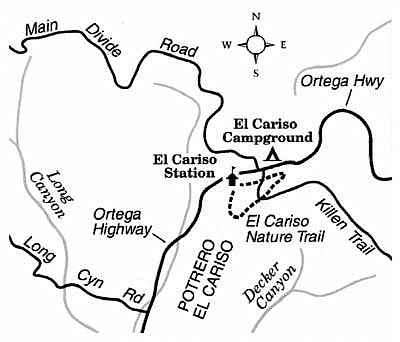 Facebook
Facebook
 X
X
 Instagram
Instagram
 TikTok
TikTok
 Youtube
Youtube
From San Juan Capistrano to Lake Elsinore, Highway 74 -- Ortega Highway -- snakes across the Santa Ana Mountains and the northernmost section of Cleveland National Forest. The roadway, completed in 1933, followed a turn-of-the-century wagon track, which in turn evolved from the route of a centuries-old Juaneño Indian Trail. The highway's rustic character remains, much to the delight of the weekend sightseer, but not the frustrated commuter trying to find an alternate route between southwestern Riverside County and southern Orange County.
Whether you drive along Ortega Highway in the eastward or westward direction, be sure to stop at the newly refurbished El Cariso Visitor Center at the crest of the highway (6 miles west of Lake Elsinore and 23 miles east of Interstate 5 at San Juan Capistrano). Inside, you'll find some small but instructive exhibits on the local flora, fauna, and geology. To learn even more, pick up a copy of the El Cariso Nature Trail self-guiding leaflet, then walk the trail itself, which begins just behind the visitor center. Anyone making a brief stop at the visitor center need not display a National Forest Adventure Pass, but anyone using the trail is supposed to.
The opportunity to become familiar with common varieties of native foothill shrubs is the real value of taking this short walk. You'll see examples of chamise, buckwheat, manzanita, scrub oak, sugar bush, and three types of sage. This month and next, monkeyflower, blue-eyed grass, nightshade, and other vivid-hued annual flowers compete for attention, while the blooms of wild peony nod circumspectly close to the ground. Amid the tangled branches of the shrubs look for the spiny, green fruits of the wild cucumber.

At the start of the trail, miner's lettuce coats the shady ground almost like a manicured lawn. There's a brief passage under some oaks, then the trail begins winding moderately upward on a chaparral- and sage-covered slope. The view to the west is of rolling country dotted with small houses on large lots (the area around El Cariso is a patchwork of national-forest and private lands).
Soon the trail levels out and turns east to circle a hilltop, passing an old mine shaft. Then it descends slightly to cross the Killen Trail (a paved road). Continue diagonally across the road and pick up the remainder of the trail, harder to follow now, but basically paralleling Ortega Highway. After meandering through a grove of planted "Penny Pines" -- Coulter pines, plus some oak and cypress trees -- you arrive back at the starting point.
This article contains information about a publicly owned recreation or wilderness area. Trails and pathways are not necessarily marked. Conditions can change rapidly. Hikers should be properly equipped and have safety and navigational skills. The Reader and Jerry Schad assume no responsibility for any adverse experience.

From San Juan Capistrano to Lake Elsinore, Highway 74 -- Ortega Highway -- snakes across the Santa Ana Mountains and the northernmost section of Cleveland National Forest. The roadway, completed in 1933, followed a turn-of-the-century wagon track, which in turn evolved from the route of a centuries-old Juaneño Indian Trail. The highway's rustic character remains, much to the delight of the weekend sightseer, but not the frustrated commuter trying to find an alternate route between southwestern Riverside County and southern Orange County.
Whether you drive along Ortega Highway in the eastward or westward direction, be sure to stop at the newly refurbished El Cariso Visitor Center at the crest of the highway (6 miles west of Lake Elsinore and 23 miles east of Interstate 5 at San Juan Capistrano). Inside, you'll find some small but instructive exhibits on the local flora, fauna, and geology. To learn even more, pick up a copy of the El Cariso Nature Trail self-guiding leaflet, then walk the trail itself, which begins just behind the visitor center. Anyone making a brief stop at the visitor center need not display a National Forest Adventure Pass, but anyone using the trail is supposed to.
The opportunity to become familiar with common varieties of native foothill shrubs is the real value of taking this short walk. You'll see examples of chamise, buckwheat, manzanita, scrub oak, sugar bush, and three types of sage. This month and next, monkeyflower, blue-eyed grass, nightshade, and other vivid-hued annual flowers compete for attention, while the blooms of wild peony nod circumspectly close to the ground. Amid the tangled branches of the shrubs look for the spiny, green fruits of the wild cucumber.

At the start of the trail, miner's lettuce coats the shady ground almost like a manicured lawn. There's a brief passage under some oaks, then the trail begins winding moderately upward on a chaparral- and sage-covered slope. The view to the west is of rolling country dotted with small houses on large lots (the area around El Cariso is a patchwork of national-forest and private lands).
Soon the trail levels out and turns east to circle a hilltop, passing an old mine shaft. Then it descends slightly to cross the Killen Trail (a paved road). Continue diagonally across the road and pick up the remainder of the trail, harder to follow now, but basically paralleling Ortega Highway. After meandering through a grove of planted "Penny Pines" -- Coulter pines, plus some oak and cypress trees -- you arrive back at the starting point.
This article contains information about a publicly owned recreation or wilderness area. Trails and pathways are not necessarily marked. Conditions can change rapidly. Hikers should be properly equipped and have safety and navigational skills. The Reader and Jerry Schad assume no responsibility for any adverse experience.
Comments